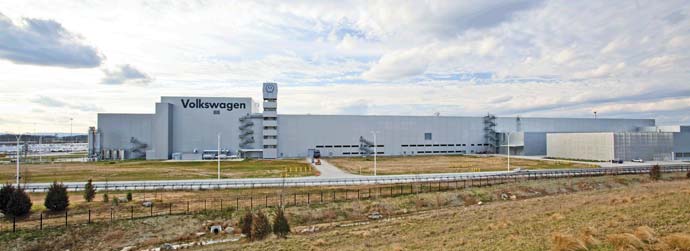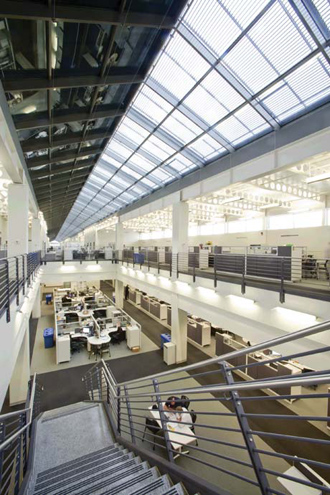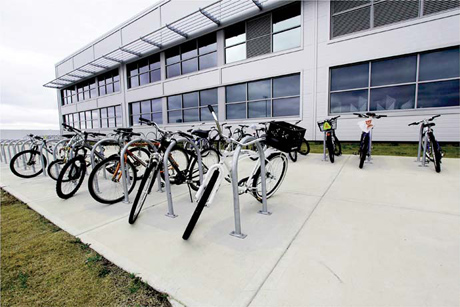In late March Volkswagen announced it would add 800 more jobs to the payroll at its new plant in Chattanooga, Tenn., expanding the work week to Saturdays and boosting the total work force to more than 3,500 by the end of 2012 — 1,500 more jobs than originally promised by VW when it made its original commitment to the plant three and a half years ago.
And that doesn’t count the US$40-million warehouse the company’s building in Roane County, Tenn. for distributing domestic auto parts for the Chattanooga-made Passat to all of NAFTA territory. The 400,000-sq.-ft. (37,160-sq.-m.) facility, also announced in March, is expected to open by spring 2013 and will employ up to 45 people by 2016.
The moves came three months after the plant and an adjacent training center, the Volkswagen Academy, achieved a global first for the industry: LEED-Platinum certification by the U.S. Green Building Council. The Volkswagen Assembly Plant earned 52 points out of 60 to earn its Platinum certification in October. The Volkswagen Academy was awarded 54 points of out 60, and received its Platinum certification in November.
“It is important to understand the tremendous growth phase Volkswagen is in,” says Dr. Jan Spies, head of factory planning for Volkswagen AG. “We are in a once-in-a-lifetime position to retrofit quite a lot of our existing plants and to come up with a couple of new plants all over the world.”
It’s only normal, he observes, to try to improve all plants’ performance, whether new or already existing. What was unique about the new Chattanooga location was its situation in a highly developed market where “the ecological perspective is much more highly developed” than in some emerging market locations. In addition, he says, the “quite difficult but highly interesting” brownfield site in Chattanooga — formerly a munitions manufacturing site for the U.S. Army — presented an opportunity for VW to set a benchmark, regardless of certifications, with which VW normally does not concern itself.
“This is what we think is affordable, correct and nice,” says Spies, noting that until SSOE Group introduced the possibility of LEED certification, “we did not know what LEED was.” But the company agreed to consider it. Brian K. Spencer, a principal division manager at Toledo-based SSOE Group, says that starting point may have been the biggest turning point, as his firm, along with St. Louis-based sustainability consulting firm Vertegy, met with VW officials to discuss the challenges involved in getting to LEED-Platinum.
“The decision to say, ‘Okay, we’re going public with our attempts at LEED certification, and take the risk the outcome is something we don’t like,’ that was a big turning point internally,” says Spies. After that commitment, he says, “to keep the train running was not that difficult.”

Risk and Reward
As it turned out, the very challenges inherent in the original parcel eventually helped drive the plant toward high-level LEED achievement. As Spies explains, the ideal site would have been as flat as a table and undeveloped, and the steep hills and valleys of the Chattanooga site were “far away from that.”
Moreover, the site’s brownfield status introduced risk, as did the presence of two streams.
“It took a huge amount of earthwork to gain those 200 hectares [495 acres] of flat land,” says Spies. But the very fact of the brownfield gave VW the opportunity to deal with water, and to embed that work into its overall plan. “With a Chinese greenfield plant we could never do that,” he says.
“The remediation is complete now,” confirms Spencer. “The site has been reseeded. Small streams have been rerouted, and we’ve added in some ponds on site.”
“We didn’t necessarily move streams because it was a brownfield site,” says Louise Schlatter, architectural department manager for SSOE and the driving force behind the LEED certification. “There were natural drainage ditches. The way it was treated was pretty innovative. The ditches were rerouted and reconstructed, and literally turned into streams.”
And the ponds, originally conceived as temporary retention ponds, are now permanent, part of an overall wetlands environment.
Spies says VW now has achieved everything it wanted to achieve when it set out to plan the plant three years ago, and has “even overachieved in a lot of respects.” Now it’s up to the team running the plant to live with those streams, with rainwater collection, with all the sustainability-oriented features, such as LED lighting, that have to prove their practicability.

Asked how much of a premium it took to go for LEED-Platinum, Spies says it was in the low single digits as a percentage of the total US$1-billion investment in the plant.
“It’s a difficult question because the VW standards we are setting ourselves, to be able to defend whatever we are doing ecologically globally. We are also doing these things in Russia, India or China. The difference between meeting minimum code requirements and meeting VW standards, when it comes to safety, environment and so on, is the bigger jump we are making. The jump financially was the easy one. This is a good confirmation of doing the right thing.”
Along the way the company has added items to its own standards that it had not considered before, such as carpool parking, which VW now is introducing at other plants as well. Earlier this year the company announced that, via its “Think Blue. Factory.” production strategy, it aimed to improve sustainability at all of its plants by 25 percent between 2010 and 2018 through such measures as energy conservation, waste reduction, emissions reduction and water consumption reduction.
Spies admits surprise at how heavily the LEED program weights such factors as individual lighting, temperature and air controls. “We did not expect that to be that important,” he says, noting that the lessons learned are being incorporated into the company’s ongoing design plans for other sites around the world. Going down the LEED path also took VW into new territory where energy modeling was concerned.
“In the past we were hesitant in giving absolute numbers,” says Spies. “LEED made us give the basis and improvement level. It’s a heavy exercise. SSOE and [St. Louis-based service provider] Vertegy had to do quite a lot of hard work with us to do the modeling of a complete plant and not just one building.”
All that said, Spencer of SSOE notes that VW’s already existing standards fit right into the LEED platform. As Spies explains, “What we normally do in plants, and in training people, is already state of the art, and for LEED it was quite easy to adapt it.”
Schlatter notes that some things have changed with the LEED certification process, however. One is the need to incorporate process load.
“Typical ASHRAE modeling for commercial buildings is a flat percentage,” she says. “But the energy use represented by the process is much more significant than that plug-in number. The USGBC reviewers understand that, and make the manufacuring facilities produce that number. We appreciate VW being as open as they were, and taking on this new requirement in the LEED program.”
It helped, adds Spies, that Chattanooga was the first plant for some of VW’s new process standards, such as new technology and energy use parameters for the paint shop, which helped the company bring down its process load. Water-oriented LEED points were quite easily incorporated into the site plan. Harder to achieve were points earned by such measuring sticks as more natural light in the plant.
Spies says the USGBC discovered that a demanding customer with a huge project has a lot of detailed questions. He calls the process “quite time consuming” and in need of improvement, but notes that the USGBC already improved a lot, and was “extremely reactive” in responding to questions or complaints.
After all, an automotive plant aiming for LEED-Platinum was untrod territory. The new VW complex represents new baselines for such elements as building process load, “and whoever follows us on the LEED path will be able to profit from it,” says Spies. That includes VW suppliers. While not a requirement, says Spies, “certification is something we highly recommend.”
Sense of Community
Rises in Importance
Spies says VW works hard to have positive community and government relations at all of its plants, but “having built plants all over the world, with lots of relationships with governors and mayors, Chattanooga has been by far the most positive we have faced in a long, long time.”
“The partnership between Tennessee and Volkswagen has been beneficial to both and serves as the perfect example of the private sector and the public sector working together,” said Tennessee Gov. Bill Haslam at the March 22 hiring announcement.
He says one strong parameter for VW when it’s seeking any site is how investment-friendly an area is. “There are lots of dimensions by which you can measure that,” he says, “but one is how easy or difficult it is to meet ecological standards. We would never go on a brownfield site if we had to start with [redevelopment] of the site ourselves.”

“I also think it’s contagious,” says Schlatter. “As VW became interested in LEED, the local municipalities caught on as well.”
“One good example was the relocation of the stream park,” says Spies. “We would not have been able to do it from an engineering and permitting point of view if Hamilton County and the City of Chattanooga had not been so supportive.”
“It’s more of a negotiated thing,” says Schlatter. “Whether the culture of the seeker of a site matches well with the municipality is the biggest item, and the rest is building the relationship from there. Projects of this size … you don’t open up your phone book and find one.”
“One of the most important things we learned in this project was that the close relationship to the community and its government is something that maybe in the past we have not estimated as high as it is,” says Spies in agreeing with Schlatter’s comment. “When it comes to site selection, we have learned yes, the financials count, but the culture we are entering, the understanding that this long-term investment fits into the community, is getting more and more important to us.”
For example, he says, “a group like mine is forced to send people around the world for from one to three years. The families joining these guys have kids who need to go to school.” So one of the most difficult challenges is to set up schools offering German curriculum in time to fit in with the project’s schedule.”
On that score, too, Chattanooga has emerged with high scores.
“It was unique that a community was able within one year to set up whatever was necessary to offer those families a good school that fits German standards,” says Spies, “and when they go back, they’re happy. All projects,” he says, “are run by people.”
“A site is not simply a site,” notes Schlatter in describing a holistic approach to site selection. “It’s not just a table to build your building on.”
VW spokesman Guenther Scherelis says the enormous amount of positive feedback about the plant has included many requests about LEED certification, “especially from Germany where LEED is not so well known.”
In the meantime, Schlatter says when she was at the LEED-Platinum announcement in December, a couple of workers told her they feel healthier than when they started back in spring 2011 when the plant first became operational. “They do a lot of walking that they didn’t do before,” she says. “I think that’s positive. People feel good while working in the plant.”
Could feeling good help you make products that make your superiors feel good too? Could be: The 2012 Passat made in Chattanooga was the 2012 Motor Trend Car of the Year.
